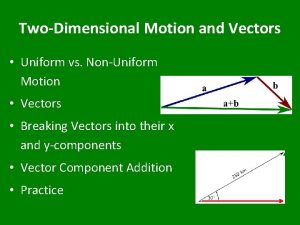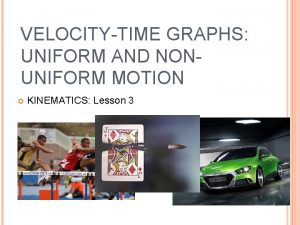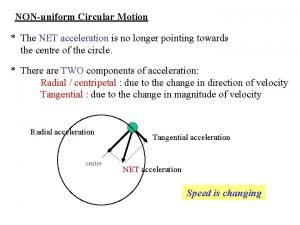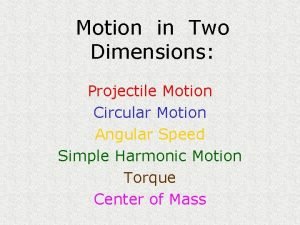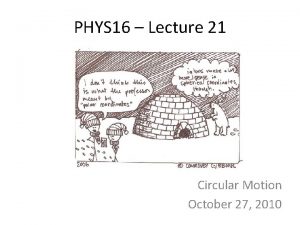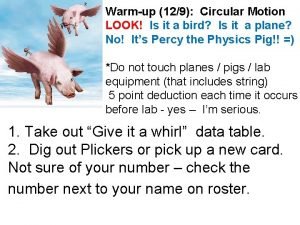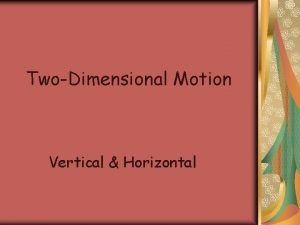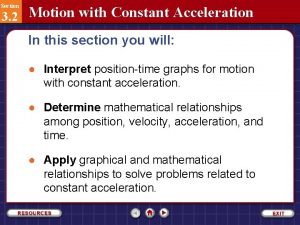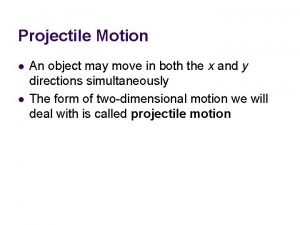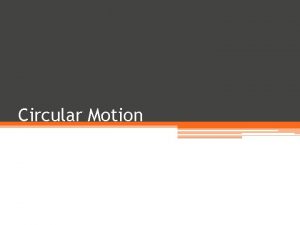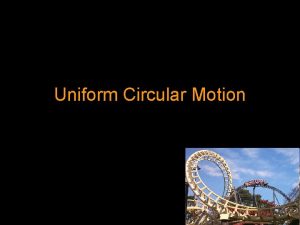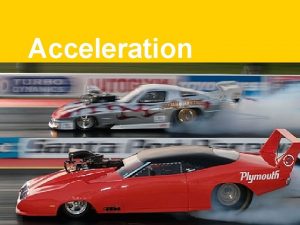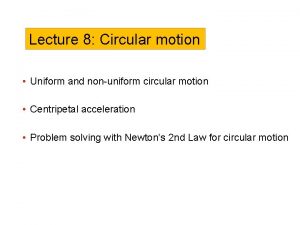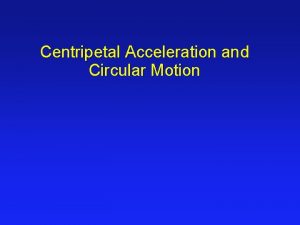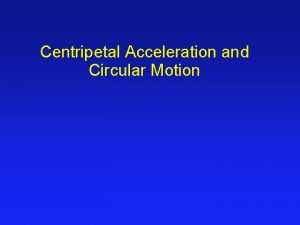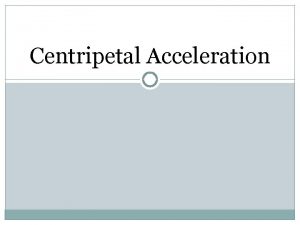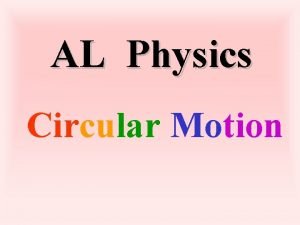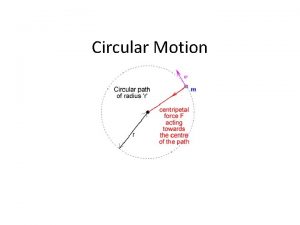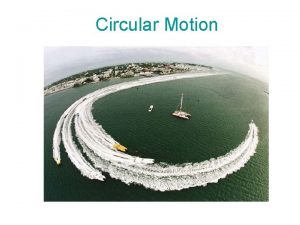NONuniform Circular Motion The NET acceleration is no















- Slides: 15

NON-uniform Circular Motion * The NET acceleration is no longer pointing towards the centre of the circle. * There are TWO components of acceleration: Radial / centripetal : due to the change in direction of velocity Tangential : due to the change in magnitude of velocity Radial acceleration centre Tangential acceleration NET acceleration Speed is changing

Examples of non-uniform circular motions Vertical circle with a string and bob string bob w Roller Coaster v

Free body diagram Change in direction Vertical circle with a string and bob Radial direction : T - mg cos q = mac = mv 2 / r string q T bob Tangential direction : mg sin q = mat mg sin q q mg mg cos q Change in speed

Can an object (mass m) go round a vertical circle of radius l if the initial speed at the bottom is u? C Can go round the circle : D B Consider Conservation of energy ; l m (1) Have enough energy to reach point C. (2) Have sufficient high centripetal force to maintain the circular motion at C. u A 0

Can an object (mass m) go round a vertical circle of radius l if the initial speed at the bottom is u? C Can go round the circle : v D T mg B Consider force at point C ; l m (1) Have enough energy to reach point C. (2) Have sufficient high centripetal force to maintain the circular motion at C. u 0 A By Conservation of energy,

Can an object (mass m) go round a vertical circle of radius l if the initial speed at the bottom is u? C Can go round the circle : (1) Have enough energy to reach point C. D B l m (2) Have sufficient high centripetal force to maintain the circular motion at C. u A The object can go round the circle if the initial speed is greater than What happens if u < ?

What happens if u < C (1) ? <u< Can reach C (as u > D B l m ) No more circular motion can be processed (as T = 0 but mg is greater than mv 2/l) u A Projectile motion due to gravity

What happens if u < C (2) D B <u< Between B and C(as u < ) Projectile motion due to gravity l m ? u A (3) u < Cannot reach B For reaching B, 1/2 mu 2 = 1/2 mv. B 2 + mgl u 2 2 gl u Swing about A between B and D

More about Circular Motion * A astronaut feels weightless in a spaceship which is moving with uniform circular motion about the Planet, say the Earth. R man Mg + mg = (M+m) v 2 / r v 2 = g r R R Mg for weightless Consider the whole system (spaceship and man), mg v R=0 Consider the man only, mg mg -R = mv 2 / r r mg -R = m(g r) / r mg -R = mg R=0

More about Circular Motion * Artificial gravity made for Space stations R R = mg’ man Rotating axis w R r w No weight as it is far away from all planets There is only normal contact reaction force due to contact N.

More about Circular Motion * Working principle of a centrifuge

* Working principle of a centrifuge (1) Assume it is horizontally aligned with liquid of density P 1 = P r inside. P 2 = P+ P (P 2 - P 1)A Pressure gradient as centripetal force FC = P A = (P 2 - P 1 )A = mrw 2 The pressure gradient increases with the distance from the rotating axis

* Working principle of a centrifuge (2) Consider an element of the liquid of density r inside. All liquid rotates with uniform speed Net force = (P 2 - P 1 )A = [m] r w 2 = [r V] r w 2 = r(A r) r w 2 Net force due to pressure gradient = r r A w 2 r

* Working principle of a centrifuge (2) Consider an element of other substance of density r’ inside. r’ r’< r for less dense object Net force Fnet = (P 2 - P 1 )A = r r A w 2 r Required centripetal force Fc = [m’] r w 2 = [r’ V] r w 2 = r’(A r) r w 2 = r’ r A w 2 r Move towards the axis r’> r for denser object Move away from the axis

More about Circular Motion * Why centrifuge ? Excess force for separation = weight - upthrust = (r’ A r g ) - (r A r g) FC = r’ r A w 2 r Fnet = r r A w 2 Fg = (r’ - r) A g r r Assume r’ > r Excess force for separation = (r’ - r) r A w 2 r Fc Typical : r = 10 cm, w = 2500 rev min-1 ~ 700 / 1
 Motion uniform and nonuniform
Motion uniform and nonuniform Graphical representation of uniform and nonuniform motion
Graphical representation of uniform and nonuniform motion Non uniform circular motion
Non uniform circular motion Normal force at top of loop
Normal force at top of loop Acceleration in circular motion
Acceleration in circular motion Acceleration in circular motion formula
Acceleration in circular motion formula Radial acceleration
Radial acceleration Relationship between linear and angular quantities
Relationship between linear and angular quantities Is radial acceleration the same as centripetal acceleration
Is radial acceleration the same as centripetal acceleration Kinetic angular energy
Kinetic angular energy Centripetal acceleration tangential acceleration
Centripetal acceleration tangential acceleration What are the elements of hair design
What are the elements of hair design Galileo view of vertical motion
Galileo view of vertical motion Translational motion diagram
Translational motion diagram Section 2 motion with constant acceleration
Section 2 motion with constant acceleration Non symmetric projectile motion
Non symmetric projectile motion
